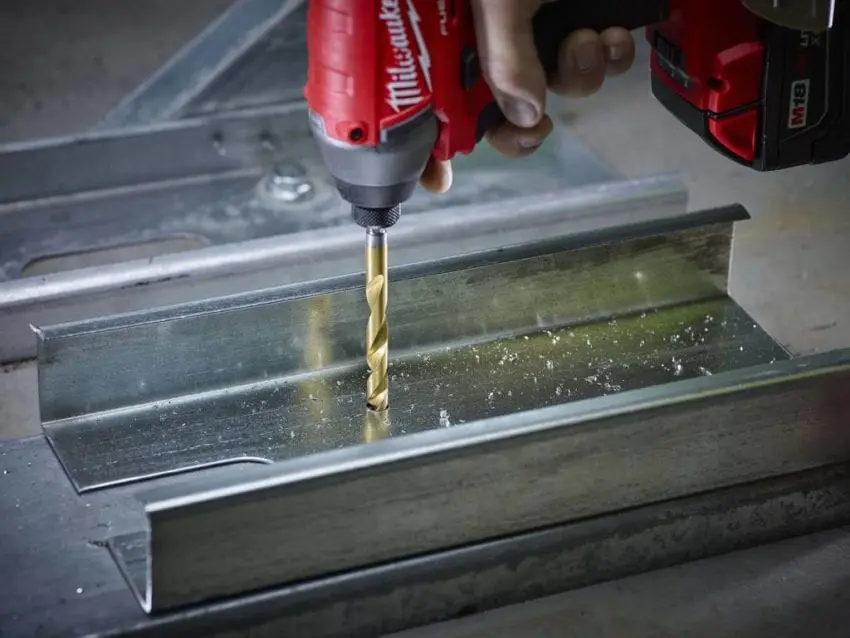The drill bit might be one of the most important, least understood, and most neglected of all cutting tools. When shopping for drill bits most people typically want to know two things: how long will they last, and how much do they cost? We had the same questions to ask about the Milwaukee Red Helix drill bits lineup. We tested both Milwaukee Shockwave Titanium drill bits and Milwaukee Cobalt drill bits. Given the different models, that took a bit longer than expected.
Milwaukee Shockwave Titanium Drill Bits
Back in 2009, Milwaukee introduced the Shockwave Impact Duty line of accessories specifically designed to stand up to elevated and extreme torque applications. In September, Milwaukee added to the Shockwave line by fielding the Impact Duty Titanium Red Helix Twist Drill Bits.
Tooled out of high-speed steel, the name is derived from a titanium nitride (TiN) coating. TiN is a ceramic material that the bit a hard outer coating and provides a thermal barrier resulting in increased production rates and longer tool life in harder materials. Milwaukee claims titanium gets 3x longer life while still providing the same corrosion protection as black and bronze oxide.
TiN-coated bits are suitable for drilling wood, iron, and steel as well as aluminum, magnesium, and similar materials. The titanium coating does, however, wear off—so these bits may not be worth sharpening as much as more expensive cobalt bits. More on that later.
Milwaukee Cobalt Drill Bits
Also in the Red Helix family (but not Shockwave) are the Milwaukee Cobalt drill bits. These bits cost more, but they thrive in hard metal applications. Use them on stainless steel and cast iron—wherever you’d be likely to dull lesser bits. Red Helix Cobalt drill bits deliver up to 10X more life than Black Oxide drill bits.
Milwaukee Titanium vs Cobalt Drill Bits
It’s worth noting some pros and cons of both materials. TiN-coated drill bits are harder than cobalt and more slippery to reduce friction. They also do better resisting corrosion. Despite this, cobalt (really a steel alloy with 5-8% cobalt) works better for drilling metal due to its high resistance to the massive heat generated when drilling through highly abrasive materials.
Cobalt bits are great for high production rates as the cobalt is found throughout the entire material. This means you can sharpen these bits without losing any performance. Bits with a titanium coating are better for general-purpose drilling on softer surfaces since the coating is only on the surface. Sharpen these bits, and you lose the benefits of the titanium coating.
Milwaukee Red Helix Bits: Design and Innovation
Variable Helix
In my opinion, here lies the real genius of this tool. You can find other cobalt and titanium bits, but this feature is truly innovative. Typical twist drills have a standard helix with the flutes being uniform all the way down the shaft. Not true of both the Titanium and Cobalt Red Helix bits. These bits start with a tight 35° twist on the helix at the tip and then spread out to 15° at the base.
The design pulls waste out of the hole at a quicker rate and with fewer rotations of the bit. Quicker waste removal reduces friction and heat that dulls bits and leads to binding and the despicable experience of snapping off a drill bit in your workpiece.
In a test of the variable helix design at the PTR Labs, we were able to repeatedly bore 1/2-inch holes over 5 inches deep in pressure-treated pine without any binding or argument from the bit. I was impressed with the smooth cutting action.
With Milwaukee cobalt bits we drilled through 1/2-inch plate steel in 30% less time than with other cobalt bits. Because all tested bits shared the same 135° split-tip, we attributed the speed gains to the chip breaker.
135° Split Point with Chip Breaker
In the past, drill point standards have been accepted based on precedent, rather than logic and design innovation. Some argue that the standard 118-degree point is wrongly assumed to be a good compromise for general-purpose drilling in a variety of different metals. Drawing from the professional drilling industry, Milwaukee has chosen to go with a more advanced split drill point and flatten the angle out to 135°.
The split point design increases the cutting edge on the tip, and the blunter 135° angle means more of the cutting edge touches the surface sooner. The tip also features Milwaukee’s new Chip Breaker design, intended to remove waste quicker and reduce bit dulling heat. All this combines to create a drill tip that cuts faster, stays sharper longer, and resists walking off-center.
Based on our testing—all of this is no joke. These bits drill very quickly.
Quad-Edge Tip
Not content to stay with existing innovation, Milwaukee announced the Quad-Edge Tip in the summer of 2019. A year later, these finally got announced for sale. This new tip adds a bump-out that helps the drill bit penetrate quickly while keeping the leading edge sharp longer.

Shank Design
Since both kits are designed for use in abrasive material, the shanks are modified accordingly. The Milwaukee Cobalt Red Helix drill bits are expected to take the most abuse. Milwaukee Tool flattened the shanks on 3 sides, giving them a better grip in a standard drill chuck.
The Milwaukee Titanium Red Helix drill bits come with a hex shank so you can toss it in your impact driver and go. Being part of the Shockwave family, they are specifically designed for this purpose.
Using the Milwaukee Red Helix Drill Bits
Over at the PTR Labs, we needed to drill mounting holes in the steel building frame to hang lighting. Chucking the Milwaukee Cobalt Red Helix Drill Bits in a cordless drill we were able to consistently drill through 1/8-inch steel framing in less than 10 seconds. The bit left a nice, clean, burr-free hole.
We also made some steel targets for the gun range—using the bits to drill 12-inch holes through 1/2-inch plate steel. As we compared the Milwaukee Cobalt drill bits to competitors, we couldn’t believe how much faster they drilled. Clean spirals of metal poured off the flutes, and the bits clocked their holes, on average, 30% faster than comparable bits from Irwin Tools and Drill America.

The 135° split point made solid contact and we had no issues with walking. Punching through was quick, easy, and accurate. In short, the experience was basically uneventful, and that’s exactly what I was hoping for. Drilling a hole shouldn’t be a major event, your bits should just work. The Milwaukee Cobalt Red Helix Drill Bits performed flawlessly.
The Cobalt bits come in 15-, 19-, 25-, and 29-piece kits while the Titanium set is offered in 10-, 15-, 23-, and 29-piece kits. Both kits are jobber length, include a 1/2-inch twist drill, and come in a sturdy case.
While the case feels durable, it holds the bits a bit too securely (and we’re being kind). It’s almost like the Milwaukee case doesn’t quite want to let its bits go! Milwaukee should consider a loose-style drill bit case for future iterations (as many of its competitors do). All in all, these are some nice twist bits.
Milwaukee Cobalt Drill Bits
- Cobalt Red Helix: 1/16″ – 1/2″ (29 sizes in 1/64″ increments)
- (48-89-2331) 15 Piece Cobalt Red Helix Kit
Milwaukee Shockwave Titanium Drill Bits
- Shockwave Titanium Red Helix: 1/16″ – 1/2″ (29 sizes in 1/64″ increments)
- (48-89-4630) 15-Piece Shockwave Titanium Red Helix Kit
- (48-89-4631) 23-Piece Shockwave Titanium Red Helix Kit
- (48-89-4632) 29-Piece Shockwave Titanium Red Helix Kit
Shop all Milwaukee Shockwave titanium drill bit kits over at Acme Tools!








